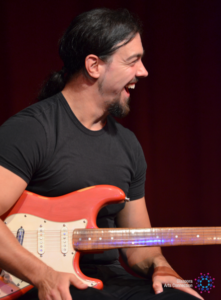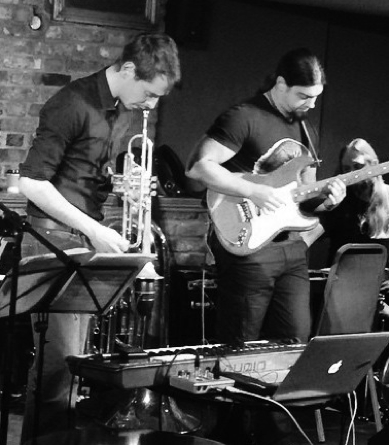Fretless Architecture:
Towards the Development of Original Techniques and Musical Notation Specific to the Fretless Electric Guitar
Read as PDF
Table of Contents
DOI: 10.32063/0401
Richard Perks
Dr. Rich Perks is a guitarist, composer, and academic based in London (UK). His research interests include the combination of composition with improvisation; cross-cultural collaborations; and the extended performance possibilities of the fretless electric guitar. He is a Lecturer in Music Performance at the University of Kent (UK), and a Lecturer in Popular Music at the Institute of Contemporary Music Performance (UK).
by Richard Perks
Music & Practice, Volume 4
Scientific
This article presents an autoethnographic account of fretless electric guitar performance, in which I interweave my experience as a performer – discoveries from collaborative projects, personal practice, improvisation and experimentation – with theoretical writing on performative practice and collaborative creativity. The article includes discussions of various processes and methodologies, including collaborations with composers, commissioning and developing new performance repertoire, and a variety of performances in different ensembles and contexts. My point of departure is that of a guitarist with 18 years as a professional and a keen interest in progressive and innovative approaches to performance, as well a composer working across many idioms. My personal experience and ‘embodied knowledge’[1] therefore verify a reliable insight into the procedural workings necessary to cultivate a unique performance practice; and as a dual practitioner–researcher, I find this format of practice-led study and critical reflection most appropriate.
Addressing contemporary violin technique, Patricia and Allen Strange observe that
The performance and compositional resources available on the violin (as well as most other instruments) are just beginning to be realized. The evolution of our own Eurocentric resources, the influence of a growing awareness of music from other cultures, the influences of current technology and the composers’ and performers’ innate curiosity are constantly driving the ‘performance pool’ of traditional western instruments.[2]
The fretless electric guitar remains relatively unexplored due to its young age and ‘prepared’[3] nature, and it features increasingly in popular music and the neo-traditional music(s) of West-Asia.[4] This account will consider its use in broader, more contemporary, and eclectic settings – both as a solo instrument and within different ensembles – and explore extended performance techniques, including an engagement with technological ‘augmentation’[5] (expressly the use of effects pedals, E-Bow etc.), to discern new timbres. I will propose a corresponding system of musical notation to represent both established and original techniques specific to the fretless electric guitar.
The development of a standardized musical notation for fretless electric guitar has thus far been neglected, likely due to a multiplicity of factors: there are few players, the contexts in which the instrument is used often do not necessitate reading (e.g. improvisatory groups, cultural music(s) which prioritize aural transfer etc.) and performance style is varied. Furthermore, there already exists a diverse array of notations for the ordinary/fretted guitar, ranging from modern electric guitar tuition methods (e.g. Hal Leonard press, Guitar Techniques magazine etc.) which provide tablature in addition to stave-based notation, to more avant-garde systems (such as those developed by composer Helmut Lachenmann[6]) which focus on ‘expanded’ forms of traditional classical guitar notation. The situation becomes further complicated when we consider the fretless electric guitar as a single component in a more complex ‘performance ecosystem’[7] – a sound generation process comprising body, touch, instrument, effects pedals, amplification, room and so forth. These variables, coupled with the fact that any notation carries inevitable limitations, and at best represents music as ‘an imaginary object’,[8] have thwarted progress in this regard. A basic approach to playing the instrument was once documented by musician Tim Donahue in a handwritten instruction booklet[9] that demonstrated various useful fingerings and exercises but contained little notation to represent the techniques themselves.
It seems to me, therefore, that if the fretless electric guitar is to be promoted to the status of ‘serious’ musical force, the development of notational guidance is paramount – particularly for its wider use by composers rooted in the Western Tradition. Furthermore, this sort of documentation will allow unique sounds and techniques to be catalogued and conserved to inform future performers and composers alike. This article outlines various performative research contexts in which I have used the fretless electric guitar, demonstrating a broad range of ‘procedural knowledge’;[10] I then propose a system of practical notations for existing techniques before moving on to discuss the development of original techniques, augmentations and textures, providing suitable nomenclature and symbolization. Various multimedia resources (audio and video) will complement the pictographic examples to enhance auditory and physical comprehension.
Immersed in the Absence of Equal Temperament: A Performative Methodology
Between August 2006 and August 2007 I spent a year living, teaching music and performing jazz in Qatar. During this time, I performed over 120 gigs in various hotels, clubs and restaurants around Doha, and the outer regions of the country. Whilst engaged in this rather close-knit performance scene, I frequently worked alongside Middle-Eastern musicians who specialized in traditional Arabic music(s) – most notably maqam-based melodies and improvisations performed on solo Oud – and was captivated by not only the microtonal modal systems and melodic content, but the techniques and subtle nuances they used for articulation.[11] I’d previously experienced similar interest when watching cellists or violinists, but something about the physicality of the Oud registered more empathetically with me as a guitarist. In 2007, having been back in London only a few weeks – and informed by very brief online research – I bought a second-hand Fender Stratocaster and proceeded to remove the frets and re-finish the fingerboard[12] to see whether I could transfer some of the sounds and techniques I’d observed into my electric guitar playing; thus began my continuing fascination with the fretless electric guitar and its expressive potential. In this section I will review a selection of performance-based environments in which I have played fretless electric guitar over the last decade, and I will consider how various elements of my performance practice have been informed by each respectively.
An accomplished performer may unwittingly carry innate prejudices or presumptions regarding the physical and sonic possibilities and/or limitations of their instrument – a forgivable position given they have studied the instrument intensely and extensively for years. A composer, on the other hand, may more likely be concerned with a specific sound itself – at a given time – with less regard for the mechanism behind its generation. Whilst this may be an oversimplification, this conceivable difference in perspective yields invaluable insights if creative collaborations between performer and composer occur. This notion is supported by Arnold Whittall’s discussion of sustained involvement between composers and performers, when he suggests that ‘such associations during the conception as well as the completion of works can have a decisive impact on the musical result’.[13]
In January 2015, I released an international ‘call for scores’ for solo fretless electric guitar in conjunction with Colchester New Music. Submissions were received from all over the world, and once the closing date was reached, I selected the five most interesting and suitable entries to work on. In November 2015, I premiered the pieces at a live performance entitled Fretless Architecture: An Exploration of The Fretless Electric Guitar at Colchester Arts Centre.[14] In March 2016, I was invited to deliver a follow-up lecture-recital at the International Guitar Research Centre’s annual conference (hosted at the University of Surrey) where, in addition to performing extracts from the original five pieces and discussing my discoveries, I premiered a new piece by composer Andrew Hall, Divisions 2. This project aimed to develop a performance repertoire for the fretless electric guitar, and to investigate the extent to which it might become an independent force as a solo performance instrument.
More pertinently though, it enabled me to collaborate, engage in dialogue, and exchange feedback with composers, over a period of approximately one year, and to advance, develop and refine several new techniques on the instrument. There were many meetings, Skype conversations, exchanges of audio examples by email and so forth between me and the composers, in which sections of compositions were worked in detail together, ensuring that specific sounds were possible, available and accurate in achieving the desired effect – or, conversely, where they were ‘tweaked’ or even replaced with more interesting or appropriate sonorities discovered through experimentation. Where new techniques or timbres were discovered, the score often remained unchanged from the original, aside from being littered with my handwritten performance directions prior to the performance. The notations suggested later (see below: Developing New Techniques: Combinations, Augmentations, and Textures) have been developed subsequently by me as I’ve endeavoured to adopt various sounds into my personal musical lexicon, and to conserve them through further composition and/or performance.
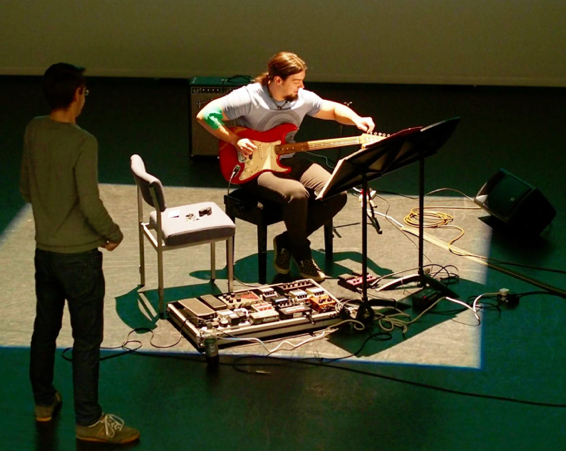
Figure 1 Working on timbres for Division 2 with composer Andrew Hall, prior to Fretless Architecture: An Exploration of the Fretless Electric Guitar. International Guitar Research Centre, University of Surrey, March 2016 (Photo: Rich Perks)
vLookup Trio is a predominantly improvisation-based ensemble comprising trumpet, percussion and fretless electric guitar, which explores the textural possibilities of an – otherwise limited – instrumentation by embracing technological augmentation (via a combination of effects pedals, MIDI-triggers, Max MSP and laptop integration among other means). Sometimes preliminary musical material is provided, acting as either a musical foundation or improvisatory ‘backbone’;[15] but in such cases, it is usually minimal in terms of form and structure. In accordance with Derek Bailey’s suggestion that ‘the essence of improvisation, its intuitive, telepathic foundation, is best explored in a group situation’,[16] the musical intention behind this ensemble is to perform highly interactive improvisatory music, with a particular emphasis on textural and timbral interconnectivity, whereby the three independent voices combine to form a ‘self-organising system’.[17] This trio have worked together for several years, and we have generated public interest by performing many concerts at significant UK venues including The Forge, The Spice of Life (see below), and Colchester Arts Centre. I have found working in this ensemble of paramount importance to my experimentation with the fretless electric guitar. As musical roles are continuously in a state of flux, there is real-time pressure to emulate the sonic properties of others, either to provide synergy or to adopt and replace the functional responsibilities of the other. (For example, a sub-octave effect being triggered by the trumpeter, whilst operating in the role of subservient support, may need immediate replacing at the point of his solo, to maintain the prevailing textual effect.) Alternatively, I may be required to initiate an improvisation and therefore define the characteristics of the soundworld to be explored. This level of consideration to sound itself, has greatly informed my use of effects pedals – especially in conjunction with the unique properties of the fretless electric guitar – resulting in the creation of original textures and an expansion of my timbral pallet (see Developing New Techniques: Combinations, Augmentations, and Textures).
Much of my more recent performative research activity involves cross-cultural collaborations, in which I primarily use the fretless electric guitar. In such environments, ‘fretlessness’ allows me to perform within non-tempered, or microtonal, tuning systems far more easily than would be the case with a standard electric guitar. Some guitarists have performed authentically in such systems using fretted instruments: Jeff Beck, for example, in his beautiful cover version[18] of Nitin Sawhney’s Nadia[19], uses his flawless tremolo bar techniques to emulate the intricate vocal articulations of the original. However, as most of the collaborations I’ve been involved in require spontaneous interaction and improvisation, and involve musicians from an array of ‘non-congruent musical backgrounds’,[20] I have favoured the use of fretless, rather than standard fretted electric guitar, as I find it offers a wider range of technical expression. In September 2017, I led a collaborative performance project entitled Strung Together in San Francisco, in conjunction with Diaspora Arts Connection. This project investigated the extent to which the improvisatory approaches of musicians from diverse musical cultures could be combined to create a programme of original, eclectic, collaborative works, within a limited time frame. Furthermore, it examined how much and what kind of musical information should be provided initially by the musical director to optimise productivity, whilst maintaining contextually relative improvisatory freedom. The ensemble comprised five professional musicians from Iran, Syria and the UK (oud, santour, saz, percussion and fretless electric guitar), each with a background in a different tradition of improvisatory music. I acted as musical director/performer, composed the preliminary musical material, and was ultimately responsible for the project’s curation and delivery. We gathered together daily for a week, and during this time we collectively developed, arranged, curated and rehearsed a complete performance programme of original, culturally eclectic music; a live performance of the show took place on the evening of the final day. The basis of the musical content was improvisation – in its broadest context – combined with the pre-composed material, which served as initial ‘vantage points’ for the development of the final pieces.
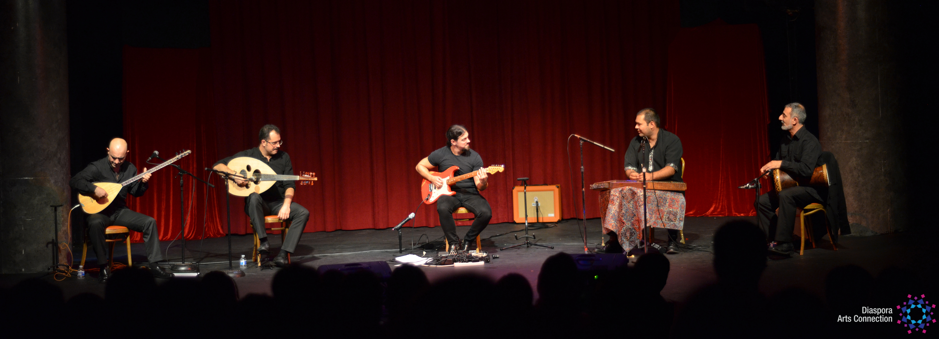
Figure 3 Strung Together: A Night of World Music Improvisation. African American Art & Culture Complex, San Francisco, September 2017 (Photo: Diaspora Arts Connection)
The idea of timbral emulation has been explored at length by the neo-traditional fretless guitarists of Turkey (such as Erkan Oğur and Cenk Erdogan), where the sound and articulation of various wind instruments (Zurna, Kaval, Ney etc.) are replicated on the fretless electric guitar using a mixture of expressive techniques, and often an E-Bow (see Established and Existent Techniques: A Proposed Notational Legend); ‘These players draw attention to the wider world of fretless guitar playing that now exists, experimenting with microtones and the modal systems found in the music of the Middle East’.[21] In 2015 I recorded all the lead guitar parts on Persian commercial artist Ali Azimi’s album Till Glory Finds Us,[22] and on the track Ahange Aroosi (Wedding Song),[23] I performed the lead guitar line on fretless electric guitar. This part incorporated a section lifted from a traditional Persian wedding theme, in which I approximated the microtonal inflections from the original tune – where this was possible within the confines of the tempered rock style backings. During the improvised fretless guitar solo, after a very idiomatically ‘rock’ opening, I emulated the timbre of a Sorna (a traditional Persian wind instrument) by using a combination of various slide and legato techniques (refer to track at 3ʹ25”), in an attempt to musically bind modern rock style with the tradition-based melodic and lyrical intention.
Such varied collaborations over the years have offered me incomparable first-hand insights into different techniques, methods of articulation, non-tempered tuning systems, and timbral emulation, allowing me to experiment with and expand my own devices of musical expression. As Amanda Bayley so elegantly writes about creativity across cultural boundaries:
Transferring this process of cultural hybridization to the practice of music-making means grappling with new ideas and translating them into something repeatable, listening to each other’s sounds and techniques and making decisions about them, and struggling with the opportunities and limitations of notation as a means to convey an imagined music – all of which may be important ways to arrive at a ‘third space’, and even a new musical language.[24]
Established and Existent Techniques: A Proposed Notational Legend
As the focus here is to expose techniques unique to the fretless electric guitar it can be presumed that, unless otherwise stated, the stave-based notation commonly used in modern electric guitar tuition materials is applicable.[25] The following section proposes a functional and accessible system of musical notation for existing fretless electric guitar techniques; all illustrative examples and symbols were produced using the industry standard notation software Sibelius so they may be easily replicable by readers.
Vibrato
There are two common approaches to vibrato on fretless electric guitar, and these have been discussed previously in several tuition resources[26] (though the name given to each type varies). Example 1 symbolises what I have termed here ‘Pivot’ vibrato. This method is akin to that customarily used by Classical strings players and is produced by ‘tilting’ the fingertip back and forth whilst maintaining pressure at a fixed position on the fingerboard. The result is a regular, smooth, and shallow fluctuation in pitch both above and below the fingered note. Example 2 depicts what I have called ‘Horizontal’ vibrato. This method is closer to that used by Middle-Eastern musicians on instruments such as the Oud. It is executed by performing a mini-sliding action, moving equidistantly back and forth along the string-length either side of the desired pitch whilst maintaining pressure on the fingerboard. This creates a ‘wider’ sounding vibrato – typically a quarter tone up and down – and is particularly effective on wound strings. Here the thicker line and the directional arrow reflect the greater degree of pitch fluctuation:
It is worth highlighting that most blues, rock and jazz guitarists favour ‘vertical’ motion vibrato – where the string is pulled upwards or downwards against the fret-wire – as this enables greater width, and arguably more control (especially if notes are sustained); in such cases however, vibrato occurs only between the pitch fingered, and some degree sharper. Wider movement below fingered pitch is only achievable by using a tremolo arm/whammy bar, or a metal/glass slide. This timbral distinction is one of the most discernible when comparing fretless and fretted electric guitars.
Slides
Unlike a conventional guitar, a fretless instrument can produce slow, even slides, in a truly portamento fashion. Despite sounding far more smooth than it does a standard electric guitar, to prevent the need to tautologically explain the difference, I have opted to use the term ‘glissando’ as opposed to ‘portamento’ throughout when referring to slides performed on the fretless electric guitar. This is consistent with classical string and trombone notation, both of which also produce truly even slides. Patricia and Allen Strange propose comparable nomenclature, when they conclude:
Glissando is academically defined as ‘execution of rapid scales by a sliding movement’, while portamento is a ‘special manner of singing in which the voice glides gradually from one note through all of the intermediate pitches’. For a string player a glissando is not scalar, and the musician does not have to sing. It simply means to slide up and down the string, producing all the possible frequencies between two extremes.[27]
Given the physical similarity of the fingerboard between violin and fretless electric guitar, it therefore seems sensible to adopt this terminology. Furthermore, ‘gliss’ is traditionally used in guitar notation to indicate a slide, and parity here prevents the need for the performer and/or composer to fuss unnecessarily over the difference when reading/writing. This said, I have taken great effort to distinguish between different types of slide, and the way each may be executed on fretless electric guitar; most of which are not possible on a standard electric guitar, where horizontal movement is more incrementally discernible. The prefix True emphasises this difference in the terminology used below.
In Example 3a the slide occurs gradually, lasting the entire duration of the first note, and the following – ‘target’ – pitch is struck at the point in time indicated; a courtesy accent placed above the note-head is recommended for clarity if a target pitch is to be plucked. Example 3b would be performed similarly, though here only the first note is plucked; the legato marking implies the target pitch is to emerge smoothly as the result of the slide. In Example 3c the initial note is struck and held at pitch until the slide begins at the point in time indicated by the tied note; the legato marking again implies the target pitch is resultant. Example 3d illustrates a series of joined legato slides, where each note length indicates the relative duration of slide; here only the first note is plucked and the subsequent target pitches are reached metronomically at the points in time indicated (note: the ‘gliss’ direction may be omitted if notes are physically close together in the score).
Example 4 illustrates a grace-note slide from one pitch to another; this is a standard decorative technique. In Example 5 only the first note is struck; subsequent notes are sustained for virtually their full duration, and the slide movements in between occur very quickly, immediately before each target pitch’s metronomic position in time.
Harmonics
Seth Josel and Ming Tsao discuss the performance of harmonics on guitar extensively, and they provide concrete notational suggestions in their book The Techniques of Guitar Playing.[28] However, this work focuses on classical and steel-string acoustic guitar notations, and purposefully omits the electric guitar; as the authors comment, ‘the vastness of the electric guitar’s sound palette in combination with sophisticated analog and digital technologies, requires that this subject be dealt with in a separate volume’.[29] The electric guitar can produce many types of harmonic through a range of techniques, using different combinations of both hands and/or a plectrum, and consequentially their notation can become complex and problematic. The following examples provide unambiguous illustrations of how the more common of these techniques may be differentially notated for the electric guitar, thus explaining the derivation of the symbolization used later for those only possible on fretless electric guitar.
Example 6 illustrates natural harmonics; these are produced by lightly touching the string with the fretting hand at a node, whilst plucking as normal, to create a ‘chiming’ effect; The diamond note-heads denote the actual pitch of the sounding harmonic. Fret position numbers[30] can be included to indicate node points, which are most commonly approximated as above frets 12, 7, 5, 4 (yielding one octave, a compound fifth, two octaves, two octaves and a third, above the open string pitch respectively[31] – in accordance with the harmonic series); string numbers in circles may be added for clarity. Example 7 shows ‘artificial’ harmonics; these are performed by fretting the note at the pitch indicated by the normal note-head in brackets, whilst simultaneously creating a node with the plucking hand (usually using the index finger) and striking to achieve a harmonic. Once again, the diamond note-heads denote the actual pitch of the sounding harmonic; fret numbers can be included to indicate node points. These are typically found at 12, 7 and 5 frets above the fingered note,[32] and string numbers in circles may be added for clarity. To produce ‘pinched’ harmonics, as shown in Example 8, notes are fretted at the pitch indicated by the normal note-head in brackets; the plectrum is then ‘pinched’ against the string with the plucking hand, producing a strong, ‘metallic’ sounding harmonic. As in the examples above, the diamond note-heads denote the actual pitch of the sounding harmonic; this technique can produce notes one octave, a compound fifth, two octaves, or two octaves and a third, above the fretted note comfortably by striking the string at different points. (Note: This technique is particularly effective with distortion.)
A more pertinent result in regards to this investigation occurs when these techniques are combined with True gliss (see Slides above), generating a group of harmonic-based timbres unique to the fretless electric guitar.
Here harmonics can slide evenly, over greater distances and at variable speeds, with accuracy – movements which are simply not viable on a standard electric guitar. Examples 10 and 11 illustrate logical derivatives of the standard techniques shown above, in so much as the first note of each is executed in the same fashion and the resultant gliss occurs simply by adding a sliding motion.[33] (Note: in both cases, the pitch of resolution has limited sustain.) A less intuitive innovation is shown in Example 9. Here the initial Natural harmonic is sounded as described above – by plucking a node approximately above the ‘fret’ five position on string three – and is followed by a ‘hammer-on’ at the same position as the original harmonic (the relative fingerboard pitch is indicated by the note-head in brackets), which may then be slid, to produce any interval available along the remaining string-length. The result is a warm, clear, ‘wooden’ sounding natural harmonic with a variable pitch.[34]
Fingernail ‘Fretting’
Another distinctive technique performed on fretless electric guitar is the ‘fretting’ of notes on the fingerboard using a fingernail. This creates a much brighter, clearer sound – as if there were in fact a fret in place on the fingerboard – and is particularly noticeable on plain/unwound strings. Furthermore, it facilitates more accurate intonation in very high registers (as the fingernail has a far smaller surface area than the fingertip). The shape of the note-heads (and F.N. direction) in Example 12 below represent the use of fingernail; slides and vibrato may be applied in conjunction:
The example in Example 13 depicts the combination of Fingernail Fretting and Pinched-Harmonic Gliss (see Harmonics above), producing ‘Fingernail Pinched-Harmonic Gliss’. This creates an ‘ultra-bright’, piercing, harmonic sound, with versatile expressive properties. A combination of Pinched Harmonics, Pinched-Harmonic Gliss, and Fingernail Pinched-Harmonic Gliss can be observed in Video 1 (at 4ʹ16ʹʹ–4ʹ31ʹʹ).
Video 1 Rich Perks, Strung Together: Fragment(s) #6 (Video: Diaspora Arts Connection)
Chords
When playing more than one note simultaneously on fretless electric guitar, it is much harder to maintain accurate intonation. That said, chords are completely viable if appropriate ergonomic limitations are considered. Certain chords which would be simple to perform on a standard electric guitar – barre chords for example – become problematic, as our fingers are not perfectly straight and therefore cannot accurately stop the strings in exactly the same vertical position; stacked fourths are generally tricky for the same reason.[35] This said, most three-note chords are playable if sufficiently spread out in the voicing, see Example 14a.
There are various advantages of performing chords on fretless electric guitar. One is that non-tempered tuning within clusters is achievable; this is particularly useful when working with classical strings players, or in cross-cultural collaborations where harmony needs ‘nudging’ to accommodate microtonal tuning systems (see Microtones below). Horizontal Vibrato may be applied to an entire chord (see Example 14b); fingerings may need to be adjusted to execute this convincingly. Furthermore, chords can be combined with True gliss to slide slowly and smoothly; more notably, the chord of resolution may adopt a different finger shape to the initial cluster (see Example 14c), creating widely spread, horizontal chordal movements unique to this instrument.
Microtones
Arguably the greatest benefit of fretless eclectic guitar is the potential execution of accurate, instantaneously accessible, microtonal pitches. This accounts for the growth of the instrument’s presence in neo-traditional music(s) of the Middle-East and West-Asia, as Erkan Oğur suggests, ‘In Makam music, the tones are not static, they are dynamic and fretlessness prevails’.[36] It would be impossible to provide a comprehensive guide to microtonal notation here, not least as different cultures have unique ways of notating such variance. For example, traditional Persian Dastgāh – in cases where music is written down – uses two unique symbols to denote Koron, and Sori (‘slightly flat’, and ‘slightly sharp’), where the degree of adjustment does not correlate to exact quarter-tones, and may vary.[37] The suggested system in Example 15 therefore provides initial guidance for notating microtonal passages for fretless electric guitar.
Intervals which lie in between the semitones of the 12-note equal tempered tuning system are comfortably playable on fretless electric guitar; in particular, 1/4, 1/3 and 1/6 tones. Here quarter-tones are denoted using standard Western symbols. To indicate other denominations, the simplest method is to add the desired fraction above the note-head, in conjunction with the ‘closest’ quarter-tone symbol; In such cases, if the interval is smaller than a semi-tone the symbol for ‘1/4-sharp’ (or flat) is used and, if the interval is larger than a semi-tone the symbol for ‘3/4-sharp’ (or flat) is used.[38] If exact microtonal pitches are required, cent indicators can be placed above note-heads in brackets.
E-Bow (Electronic Bow)
Augmentation is discussed in the next section; but given that the use of E-Bow is relatively commonplace in the fretless electric guitar community, an initial discussion is apt here. The E-Bow creates a magnetic field, which when held close to a guitar string, stimulates movement, providing infinite sustain.[39] When used on fretless electric guitar, even slower and limitlessly legato passages can be executed (within the pitch confines of one string; see Example 16).
The example in Example 17. illustrates Infinite Harmonic Gliss. Here the harmonic is created by the E-Bow’s +8ve-harmonic function. Notes in brackets represent pitches fingered, and diamond note-heads indicate actual sounding pitch; note lengths indicate relative time-distance between pitches; string numbers may be added for clarity.
An example of Infinite Gliss combined with microtonal inflections, using and E-Bow, can be observed in Video 2 (at 2ʹ05ʹʹ – 4ʹ02ʹʹ).
Video 2 Rich Perks, Strung Together: Fragment(s) #1 (Video: Diaspora Arts Connection)
Developing New Techniques: Combinations, Augmentations, and Textures
This section considers the development of original techniques and timbres through experimentation, personal practice and collaborations with composers and/or performers, in different performative contexts, highlighting the reflexive relationships between various musical practices and the advancement of instrumental technique.
Fingertip and Intermittent Muting
Palm Muting (Example 18) is a common technique that can be performed on any electric guitar by resting the palm of the plucking hand on the strings and picking the notes as normal; the resultant effect is a softer, less resonant, version of notes, sounding at the desired pitch. When rehearsing prior to the recording of Double Exposure[40] – an improvised graphic score interpretation performed by marimba and fretless electric guitar duo – I wanted to emulate the timbre of the marimba and execute similar fast, highly discernible runs with a more ‘wooden’ tone. Conventional palm muting enabled me to achieve this to a point, but it comes with partial physical restrictions of the plucking hand, making the momentary incorporation of vertically moving techniques such as sweep-picking or string-skipping more difficult.[41] To realize the desired effect, I started experimenting by muting notes with my fretting hand, and developed ‘Fingertip Muting’ (Example 19).
This is essentially a variation of what is commonly referred to as ‘half harmonic pressure’, a technique employed by contemporary stringed instrument players whereby pressure on the fingerboard is intentionally ‘under-applied’, generating a sound somewhere between a natural harmonic and a ‘normal’ note. The amount of pressure applied can vary greatly, however, and the resulting possible ratios of ‘noise’ to ‘pitch’ are numerous; the name is thus somewhat ambiguous and represents multiple timbres depending on the degree of stopping pressure.[42] Dimpker comments that ‘when executing half harmonic stops on the guitar, the string hits the frets when plucked and an additional buzzing sound evolves’,[43] and one can intuitively understand that if further pressure were applied at this point, the sound would quickly represent a fully-fretted note. Conversely, if more pressure were relieved, the sound would become abstractly different – due to the complete lack of engagement with the fingerboard – emphasizing the harmonic properties and losing the fundamental pitch. On a fretless electric guitar, the string cannot hit the frets of course, and therefore one may apply more pressure before a ‘normal’ note is sounded, thus introducing an even greater range of sonic possibilities. At the extreme of these, once a note is very close to being fully stopped, the timbre appears more like a muted note than a natural harmonic. These notes fundamentally sound at pitch, and convey a ‘wooden’ quality, accompanied by only a very subtle harmonic ‘sparkle’; the attack from the plectrum remains exquisitely clear, and the plucking hand is free to perform any movement, uninhibited. To be clear, therefore, when discussing Fingertip Muting here, I am referring to a specific form of half-harmonic pressure whereby the pressure applied is approximately 4/5 to 5/6 that of a fully-stopped note; and I wish to distinguish this sound from more equidistantly distributed executions. Fingertip Muting can be heard in Audio 1 (at 3’15”–3’40”).
Audio 1 Rich Perks, Double Exposure (2009) (Audio: Rich Perks)
I further explored muting techniques when practising Andrew Hall’s Divisions as part of my Fretless Architecture project (see Immersed in the Absence of Equal Temperament: A Performative Methodology, above). Hall is a trumpeter as well as composer, and rather interestingly included muted (+) and unmuted (o) notes within a very fast passage in this score (see Example 20.):

Example 20 Excerpt from Divisions[44] by Andrew Hall (Score: Andrew Hall)
Here notes within the dotted line are presumed muted unless otherwise stated; this notation may be used in conjunction with both palm muting and Fingertip Muting. In the example above, the first accented note is still muted (though played louder); the open symbol (o)[45] implies the note is to be fingered normally (or without palm if depicting palm muting).
Screeching
Turbulence by Julia Usher – a submission to the Fretless Architecture call for scores – took advantage of many of the techniques unique to the fretless electric guitar. The piece moves continuously through various soundworlds, and as such requires constant manipulation of effects pedals, changing between techniques, and production of textures. One new timbre which came as a direct result of working with Julia, is ‘Screeching’. In the final section of this piece, Julia wanted notes to be played with the E-Bow, and to gradually descend, moving between normal and harmonic slides (see Example 22).

Example 22 Excerpt from first draft of Turbulence[46] by Julia Usher. (Score: Julia Usher)
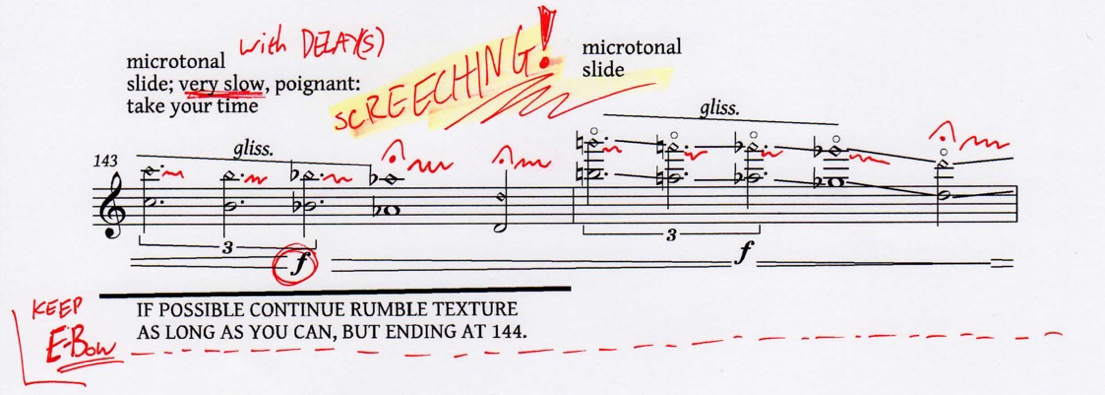
Example 23 Excerpt from final draft of Turbulence by Julia Usher, with added performance directions (Score: Julia Usher)
Video 3 Turbulence composed by Julia Usher. Performed by Rich Perks as part of Fretless Architecture, at Colchester Arts Centre, 2015 (Video: Rich Perks)
This example echoes the findings of Henrik Frisk and Stefan Östersjö, demonstrating ‘the recursive nature of the interplay between constructive (poietic) and interpretative (esthesic) processes both in the communication between the composer and the performer, but also as an internal process in which the composer himself is negotiating between the original vision and its representation in musical notation.’[47]
Subsequently, this technique (and timbre) has become an integral part of my musical vocabulary as a performer, and I have used it in many improvised performances. Example 24 provides a modified notation for this technique, differentiating it from those similar presented earlier (see Example 17). Here, notes in brackets denote the fingered pitches within a multidirectional gliss and the diamond-head notes indicate the audible pitch. The glissandos have a defined trajectory and Horizontal vibrato is performed at each ‘emphasis’ point, where that note is held slightly longer. The delay(s) generate colliding microtonal beats throughout (represented by the narrow wiggly lines), created from the continuous overlapping of slides and Horizontal vibrato. All together these qualities produce a ‘Screeching’ sound.
Extreme and Variable Vibrato
Through performing improvised music(s) in various ensembles, I have cultivated several progressive forms of vibrato. The two examples here, ‘Extreme’ and ‘Variable’ vibrato, emerged when I was improvising with a theremin player, in an attempt to replicate his ‘ultra-wide’ vibrato. I originally devised the notation below as part of the guidance notes disseminated to composers for the Fretless Architecture call for scores.
Example 29 illustrates Extreme vibrato, a wider form of Horizontal vibrato whereby the specific pitch-variance is stipulated by adding ‘+/- an interval’ above the line; in this example the motion would fluctuate between a major second either side of the fingered pitch (i.e. from A to C#). Larger intervals may be used, though the physical properties of the fingerboard must be considered (e.g., as note spacing is far larger at the lower end of the neck, fluctuation of +/- 5th would be impossible at speed); notating the string number is therefore recommended for clarity. In Example 30, vibrato starts with Pivot technique and gradually merges into Horizontal, through to Extreme, thus providing gradual variation in vibrato width. Similar ideas have been conveyed before in pieces written for violin,[48] the difference here being that the technique itself must alter, mid-execution, in relation to the pitch-variance to achieve the desired effect; this combination of techniques allows for a broad, yet specifically determined range of motion.
Textures, Augmentations, and Graphic Representation
The use of electronic augmentation allows musicians to produce elaborate textural soundscapes. This is an enormous field of research, with an infinite number of sonic possibilities, created through boundless technological enhancements. The ideas presented here therefore are limited to textures developed through my performance with the fretless electric guitar combined with effects pedals and E-Bow. The notation I use to ‘conceptually archive’ these textures, and subsequently depict them within compositions, is provided for each. These graphic representations will of course be ambiguous and open to interpretation if performed by others, but I hope that some degree of the intended effect might be conveyed to performers in such instances.
Example 27[49] represents a texture I use often in live extemporizations, which I refer to as ‘Underwater’; it is taken from the score of Trio Mash #1 (Salien), a piece written for vLookup Trio. A live performance can be heard in Audio 2, from the opening section.
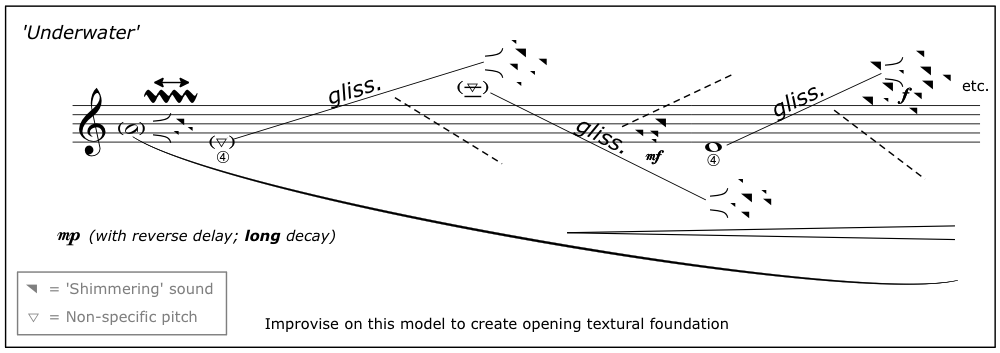
Example 27 Excerpt from Trio Mash #1 (Salien) by Rich Perks, depicting ‘Underwater’ texture (Score: Rich Perks)
Audio 2 vLookup Trio performing Trio Mash #1 (Salien) (Audio: vLookup Trio/Rich Perks)
Example 28 depicts a texture I call ‘Wild Wide-Octave Gliss’; it is taken from the score of Nexus,[50] a piece written for piano and fretless electric guitar. It is created by augmenting True gliss with a polyphonic octave generator – in this case with the direct signal completely removed – and decorating with arbitrary, indeterminate ‘scratchy noises’, whilst maintaining delays. The result is base of widely spaced glissandos, with jarring ‘noise’ embellishments.

Example 28 Excerpt from Nexus by Rich Perks, depicting ‘Wild Wide-Octave Gliss’ texture (Score: Rich Perks)
Conclusion
This article has considered the physical and pictorial embodiment of performance techniques specific to the fretless electric guitar and has proposed a starting point for conservation and dissemination. The processes outlined in the latter section demonstrate the reflexive advantages of composer–performer collaborations and their potential impact on the advancement of instrumental technique, re-emphasizing the importance of ‘a “research” phase in which a composer works with one or more performers’,[51] and the resultant mutual benefits. This is not to overlook the significance of performer–performer relationships, as confirmed here in the context of exploratory improvisation-based ensembles. In both instances, not only does the instrumentalist’s consideration of technique expand as a direct result of pragmatic alliance, but a feedback loop occurs from musical practice, through experimentation, embodiment, dissemination, back to practice, stimulating the continual conceptualization and discovery of new sounds by composer or performer alike. The diagram in Figure 4 illustrates this cycle in relation to the work and methodologies presented here.

Figure 4 Relationship between musical practice and development of original instrumental techniques (Image: Rich Perks)
In summary, whilst from a reductionist perspective one may argue that the only discernible characteristic of the fretless electric guitar, when compared to its fretted counterpart, is its ability to facilitate smooth, horizontal motions along the string-lengths, this research has led me to discover that it is the subtle nuances, inflections and expanded expressive possibilities provided by this ‘liberation’ that are becoming increasingly attractive to the modern explorative guitarist.
As Erkan Oğur orates:
Fretlessness allows for a broader range of tonal possibilities and expression. However, one needs to have the sufficient knowledge and experience for it. Philosophically, fretlessness, or to be more precise ‘to pull the curtain up’ (in Turkish the word for curtain is also used for fret) provides the will to live equally and lovingly with all the beings in the world. To play a fretless instrument means freedom.[52]
Finally, I believe the dissemination of these techniques and timbres to the wider musical community, through both performance and documentation, will impact on the future realization of sounds in musical practice(s), and thus affirm this instrument’s authority as a musical force in broader musical contexts.
Endnotes
[1] Robin Nelson, Practice as Research in the Arts: Principles, Protocols, Pedagogies, Resistances (Basingstoke: Palgrave Macmillan, 2013), pp. 37–44.
[2] Patricia Strange and Allen Strange, The Contemporary Violin: Extended Performance Techniques (Lanham, MD: Scarecrow Press, 2003), p. viii.
[3] Michael Nyman, Experimental Music: Cage and Beyond (Cambridge: Cambridge University Press, 1974), p. 20.
[4] Kevin Dawe and Sinan Cem Eroğlu, ‘The Guitar in Turkey: Erkan Oğur and the Istanbul Guitarscape’, Ethnomusicology Forum, 22/1 (2013), pp. 49–70.
[5] Osto Lähdeoja, Benoît Navarret, Santiago Quintans, and Anne Sedes, ‘The Electric Guitar: An Augmented Instrument and a Tool for Musical Composition’, Journal of Interdisciplinary Music Studies, volume 4/issue 2 (2010), p. 42.
[6] Lachenmann’s Salut für Caudwell (for two guitarists) (Wiesbaden Breitkopf & Härtel, 2000), provides a suitable example.
[7] Simon Waters, ‘Performance Ecosystems: Ecological Approaches to Musical Interaction’, Paper presented at the Electroacoustic Music Studies Network EMS-07 Proceedings, Leicester, UK, 12–15 June 2007, available at www.ems-network.org/spip.php?article278 (accessed 25 November 2018).
[8] Nicholas Cook, Music: A Very Short Introduction (Oxford: Oxford University Press, 1998), pp. 51 –73.
[9] Tim Donahue, Fretless 6-String Technique (Unpublished: originally distributed by Selva Guitars as a complimentary guide with their TD model fretless electric guitar), available at www.unfretted.com/lessons/fretless-guitar-technique (accessed 3 March 2018).
[10] Nelson, Practice as Research in the Arts, p. 41.
[11] Cameron Powers, Arabic Musical Scales (Boulder, CO: GL Design, 2005), pp. 4–5.
[12] It is worth noting that the procedure of converting a fretted electric guitar to fretless carries several inherent pitfalls, and one must be extremely careful to not damage the fingerboard in the process. In particular, the lacquering of the fingerboard must be conducted with caution to ensure it is even, smooth and fully functional.
[13] Arnold Whittall, ‘Composer–Performer Collaborations in the Long Twentieth Century’, in Distributed Creativity: Collaboration and Improvisation in Contemporary Music, ed. Eric F. Clarke and Mark Doffman (Oxford: Oxford University Press, 2017), p. 21.
[14] A complete archive of videos, audio recordings, and scores from this project can be found at www.richperks.co.uk/fretlessarchitecture.html.
[15] Timothy James Steiner, Composition: Interaction & Collaboration (PhD Thesis, City University of London, 1997), pp. 112–13.
[16] Derek Bailey, Improvisation: Its Nature and Practice in Music (New York: Da Capo, 1993), p. 112.
[17] David Borgo, Sync or Swarm: Improvising Music in a Complex Age (New York: Continuum, 2005), p. 126.
[18] Jeff Beck, You Had It Coming, Epic/Sony Records, 2001, Track 5.
[19] Nitin Sawnhey, Beyond Skin, Outcaste, 1999, Track 6.
[20] Richard Perks, Combining Musical Identities Through Composition and Improvisation (PhD Thesis, Brunel University, 2013), p. 6.
[21] Kevin Dawe, The New Guitarscape in Critical Theory, Cultural Practice and Musical Performance (London: Routledge, 2016), p. 35.
[22] Ali Azimi, Till Glory Finds Us, Independent release, 2016.
[23] Track available at www.soundcloud.com/aazimi/ali-azimi-till-glory-finds-us-06-ahange-aroosi-wedding-song (accessed 3 March 2018).
[24] Amanda Bayley, ‘Cross-Cultural Collaborations with the Kronos Quartet’, in Distributed Creativity: Collaboration and Improvisation in Contemporary Music, ed. Eric F. Clarke and Mark Doffman (Oxford: Oxford University Press, 2017), p. 111.
[25] For a reliable, modern legend of electric guitar notation see: Guitar Techniques, Issue 263 (December 2016), p. 97.
[26] Jeff Berg, Fretless Guitar: The Definitive Guide (n.p.: Unfretted.com, 2014), p. 43.
[27] Strange and Strange, The Contemporary Violin, p. 79.
[28] Seth Josel and Ming Tsao, The Techniques of Guitar Playing (Kassel: Bärenreiter, 2014), pp. 98–137.
[29] Josel and Tsao, The Techniques of Guitar Playing, p. 13.
[30] Fret numbers act as rough guidance only.
[31] These are those most commonly performed, though more pitches are achievable as the string length continues to be shortened.
[32] ‘Tapped’ Harmonics – a variant of artificial harmonics – are denoted the same way, but with the letters T.H. above; here the node is ‘tapped’ by the plucking hand to sound the harmonic; these are easier to execute quickly, and with string skips.
[33] These two techniques can only be performed on a standard electric guitar if the slide itself is executed very quickly. A similar sound to Pinched-Harmonic Gliss may also be produced on a standard electric guitar with the use of a tremolo bar or metal/glass slide, but it is limited in terms of versatility and is far harder to execute with accuracy.
[34] Sometimes a secondary slide may be audible, moving in the reverse direction. This is caused by the physical properties of the hammer on part way along the fingerboard, and, if undesired, may be avoided by ‘masking’ the string (i.e. simultaneously placing another finger on the string behind the finger performing the hammer on). A variation of this technique may also be performed on a fretted guitar using a metal/glass slide, though the timbre is far brighter.
[35] If writing chords from a non-guitarist perspective, I would encourage checking with the performer to ensure they are possible.
[36] Erkan Oğur in conversation, online interview (January 2014) www.theguideistanbul.com/article/erkan-oğur-fretless-philosopher (accessed 25 March 2018).
[37] Hormoz Farhat, The Dastgāh Concept in Persian Music (Cambridge: Cambridge University Press, 1990), pp. 7–18.
[38] Unless a specific enharmonic implication is intended within a piece, it is far more practical to notate the microtonal pitch by the smaller fraction. For example, A 2/3-tone flat would be easier to read if written as G 1/3-tone sharp etc.
[39] A full description, as well as guidance for standard E-Bow techniques can be found at www.ebow.com (accessed 26 March 2018).
[40] Rich Perks, Imposition, Independent release, 2009, Track 5.
[41] Guthrie Govan, Creative Guitar 2: Advanced Techniques (London: Sanctuary, 2002), p. 35.
[42] This idea is detailed further (and demonstrated) at www.cellomap.com. Cello Map is a research project of the Department for Research and Development at the Hochschule für Musik, Basel, Switzerland.
[43] Christian Dimpker, Extended Notation: The Depiction of the Unconventional (Berlin: LIT Verlag, 2013), p. 162.
[44] Divisions, for Solo Fretless Electric Guitar, Composed by Andrew Hall (2015), for Fretless Architecture call for scores.
[45] Not to be confused with Classical guitar notation for harmonic; here the ‘open’ instruction only occurs within a muted passage.
[46] Julia Usher, Turbulence, for Solo Fretless Electric Guitar (Primavera Music, 2014).
[47] Henrik Frisk and Stefan Östersjö, Negotiating the Musical Work. An Empirical Study (2006), available at www.researchgate.
[48] Strange and Strange, The Contemporary Violin, p. 73.
[49] Taken from Trio Mash #1 (Salien), Composed by Rich Perks (2013); Premiered by vLookup Trio at Spice of Life, London (2013).
[50] Rich Perks, Nexus, for Piano and Fretless Electric Guitar (2017).
[51] Eric F. Clarke, Mark Doffman, David Gorton and Stefan Östersjö, ‘Fluid Practices, Solid Roles?’, in Distributed Creativity: Collaboration and Improvisation in Contemporary Music, ed. Eric F. Clarke and Mark Doffman (Oxford: Oxford University Press, 2017), p. 132.
[52] Erkan Oğur, January 2014, online interview, www.theguideistanbul.com/article/erkan-oğur-fretless-philosopher (accessed 25 March 2018).

